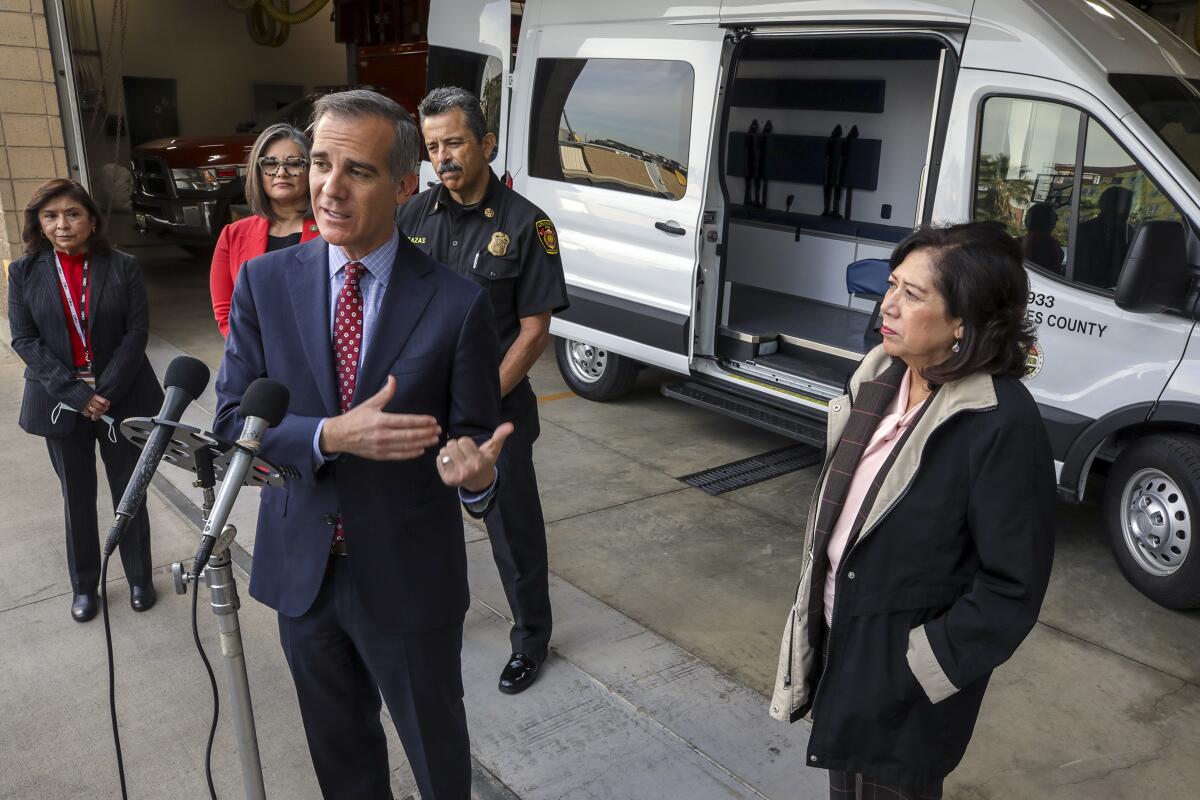LAFD calls on city to end pilot program that sent health workers to 911 calls

- Share via
The Los Angeles Fire Department has recommended ending a pilot program that sends mental health workers to non-emergency calls, saying it didn’t actually free up first responders and hospital emergency rooms.
The recommendation was made by Peter Hsiao, assistant chief of the Emergency Medical Services Bureau, in a report submitted to the Los Angeles Board of Fire Commissioners at its Tuesday meeting. The board did not discuss the item, which now will be sent to the L.A. City Council for its consideration.
In his report, Hsiao said that the idea behind the therapeutic van pilot — sending a van staffed with a psychiatric response team instead of LAFD paramedics or emergency medical technicians to handle 911 calls involving patients suffering nonviolent mental health crises — was “sound in theory” but not in practice.
He wrote that workers with the county Department of Mental Health “lacked the requisite training and thus were unqualified to perform medical assessments or provide emergency medical services.”
Los Angeles announces launch of mental health response teams
Hsiao said the lack of training offset any benefit to the Fire Department and its resources. Last year, he wrote, fewer than four patients each day met the narrow criteria established for transport by a therapeutic van. He said the mental health agency made several efforts to increase the usage of the van but still fell short.
The pilot program, a partnership between the city and the Department of Mental Health, officially launched in the fall of 2021 and has cost nearly $4 million. The vans operate 24 hours a day, seven days a week, and are staffed with psychiatric mobile response teams that include a driver experienced in transporting patients to and from health and mental health facilities, a psychiatric technician and a peer support specialist. The vans were placed at five fire stations throughout the city.
The program’s launch, which city and fire officials praised, came amid the public’s frustration over the city and county’s handling of the homelessness crisis, which has been intensifying for years. It also coincided with Gov. Gavin Newsom’s plan to push more people with severe mental health and addiction disorders into court-ordered care that includes medication and housing.
The Department of Mental Health did not respond to a request for comment.
The therapeutic van program already faced issues when the city sought to expand it in 2023. At the time, LAFD raised concerns about the program’s limitations, stating that many of the patients required emergency care and first responders could not transfer them to the therapeutic vans. There was also a staff shortage that prevented some of the vans from operating more than 12 hours.
L.A. County says it needs a federal fix to make sure Angelenos with out-of-town area codes can access local services when they call 988.
In his report, Hsiao said the Fire Department was simultaneously operating another program with capabilities similar to the therapeutic van program but with a greater scope of service.
These advanced provider response units, Hsiao wrote, consist of an EMS advanced provider who is either a nurse practitioner or a physician assistant and an LAFD firefighter or paramedic.
The units are capable of treating and assessing voluntary and involuntary mental health patients, including writing so-called 5150 holds to temporarily institutionalize people at risk to themselves or others. The units are also able to provide emergency care and write prescriptions.
“Patients experiencing mental health crises in conjunction with medical, violent or substance abuse issues require a responder with broader capabilities and preferably the ability to transport to non-traditional receiving facilities,” Hsiao wrote in his report. “These functions are largely satisfied by the [advanced provider response units].”
Hsiao said leftover funds allocated for the therapeutic van should go to other programs, such as advanced provider response units.
More to Read
Sign up for Essential California
The most important California stories and recommendations in your inbox every morning.
You may occasionally receive promotional content from the Los Angeles Times.
















